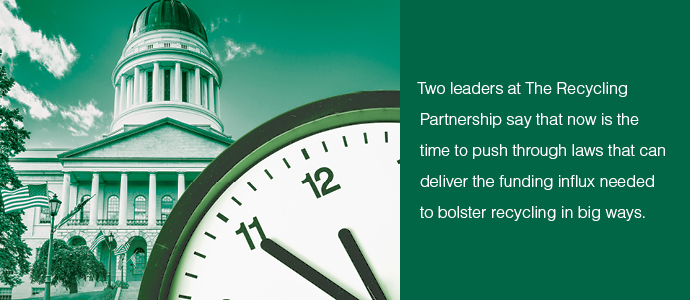 This article appeared in the June 2022 issue of Resource Recycling. Subscribe today for access to all print content.
This article appeared in the June 2022 issue of Resource Recycling. Subscribe today for access to all print content.
Last year, Maine and Oregon each passed major pieces of recycling legislation that incorporated elements of extended producer responsibility (EPR) for packaging, a strategy in which producers are mandated to fund packaging recovery in those states. This spring, lawmakers in Colorado sent an EPR package to the governer’s desk
In addition, aggressive recycled content mandates have passed in several states, bottle deposit systems are receiving renewed interest, and packaging EPR bills have shown up in more legislatures across the U.S.
But there are also signs that recycling policy is becoming more contentious, with groups representing different materials and industry sectors becoming more clear in their concerns over some legislated approaches.
To help offer some perspective, Resource Recycling recently talked with two leaders from The Recycling Partnership, Keefe Harrison and Scott Mouw. They have decades of experience working toward municipal recycling progress and balancing the needs of communities, private-sector service providers, brands and others.
Resource Recycling: Why do you think recycling policy conversation has gone into overdrive over the last several years? It seems like not too long ago that EPR in a U.S. state was a seemingly far-fetched idea, and now here we are, with laws in place in Maine and Oregon and lots of legislative activity elsewhere.

Scott Mouw, senior director of strategy and research, The Recycling Partnership
Scott Mouw: We have to remember that recycling policy and EPR discussions have been on a long journey. In 2010, a handful of states and local governments persuaded EPA to convene a dialogue with brand companies about sustainably financing the U.S. recycling system. At the time, I was one of those state officials and the subtext of that dialogue was the idea that producer financing could move the system past a stagnation that continues to this day. We continue to rely on thousands of disaggregated local parties to decide what recycling services are made available to the public. Is that what we want going forward?
At the time of the EPA dialogue, brand companies were opposed to the idea of producer-based financing, but now it is clearer than ever that U.S. recycling cannot move forward without systemic change. In the interim, communities and states have had to weather the ups and downs of commodity markets, which has tended to erode the system further. But these same circumstances have energized policymakers to look at policy solutions, creating the EPR momentum we see today. Beyond financing, with climate change now growing more serious, many people are also interested in seeing recycling deliver GHG benefits at a much higher scale.
Keefe Harrison: In addition, many brands and commodity groups now realize that their recycling and packaging sustainability goals simply cannot be met unless the U.S. recycling system takes a leap forward. That’s a good thing because it has built a common understanding in both the public and private sectors that policy can help drive a better system. So now we see a shift to acceptance and, in many cases, support for policy that can establish a truly robust recycling system.
Policy of course can take many forms – not just EPR. What are the key policy levers? What does recycling policy done right look like?
Harrison: Before we start comparing one policy to another, I think it’s important to step back and ask, “What are we trying to achieve?” The Recycling Partnership is looking to deliver the system of the future where all homes have equitable access to recycling and we double the U.S. residential recycling rate.

Keefe Harrison, CEO of The Recycling Partnership
How do we get to that future? Last year, The Recycling Partnership produced a report called “Paying It Forward” to outline what that robust system would look like and what it could deliver. A $17 billion investment over five years to maximize the U.S. residential recycling system would make recycling as accessible as garbage collection to all households – nearly 40 million U.S. households lack that equitable access. The investment could double the U.S. packaging recycling rate and deliver a return of $30.8 billion over 10 years (including wages, taxes, landfill savings and the value of recyclables). That’s an investment we can’t afford not to make. Of course this is a cap-ex and op-ex game. First you need to level up the system – then you need to operate it.
I often get asked if I’m for or against deposits or pay as you throw. I’m not opposed to those steps. Deposits can be a very effective tool for recovering more of certain types of products. PAYT helps the public more clearly understand the true cost of disposal. They are good steps that could be part of a collective whole, but before we start pitting one tactic against the other, I hope we as recyclers come together to use this moment in time and drive for big change. If folks are interested in what we are trying to achieve and haven’t read “Paying it Forward,” I hope they take a flip through the executive summary – we break out what type of capital is needed where, what types of sectors have made investments to date, and what a stronger system could deliver for all of us, if we work together.
Mouw: I agree. I hope we recyclers consider these policy levers from a lens of not just how we finance individual aspects of the system – it’s about building something bigger, and better, together. The current interest in policy should be a moment for our industry to come together to grasp this chance to launch something new. Instead of gradual change, we could co-create a powerful new system.
A lot of people across this country have worked a long time for this moment, and I hope we’re able to make the most of it. Ultimately, the often long road of policy development and actual passage of legislation depends on educated and motivated legislative champions stepping forward and finding enough business community support (or at least acceptance) to get their bill through.
When talking municipal recycling, the reality on the ground is so different from community to community. How can effective policy be developed at the state level – or even national level – so that cities and counties can still adjust to what’s needed in their local area?
Mouw: It is important for communities to see themselves as part of the policy process and to be engaged as much as they can be. That can be hard given that their primary focus is on running a recycling program – so making sure the trucks are on the street and recycling services are being delivered. But by participating in the policy debate, communities can ensure their citizens are well-served by whatever the policy produces, and they can protect the environmental interests that drove recycling services in the first place.
Harrison: Scott and I both came from the public sector – we’ve run recycling programs and worked at the state level. The entire staff at The Recycling Partnership has that on-the-ground perspective top of mind in everything we do. That’s why we want to ensure that communities don’t just “adjust to” policy but also help shape it. The work we do every day with communities across the U.S. helps us bring those voices forward. We encourage legislative champions to ensure that community voices are sought out and included. And private-sector supporters of policy should also recognize the experience and interests communities have in running recycling programs.
As stronger recycling policy has been discussed in more concrete terms in the U.S., different companies and groups have certainly added their voice to the conversation, sometimes in very powerful ways. Are we at risk of derailing potentially helpful policy because there is so much debate around the details?
Mouw: Details are essential in establishing effective legislation, and that includes anticipating that no law ultimately passed will answer all the questions and contingencies. We are at a critical juncture where two states have passed EPR laws with very different details, both with processes underway to address the items that their respective laws left open. Let’s imagine that three or five more states pass packaging EPR bills that differ in their approach. We then have a reprise of the disjointed approach that occurred around state electronics EPR laws from the early 2000s, each differing in their details. For many companies and groups, that is a recipe for disaster.
In short, the easiest way to derail “potentially helpful policy” is to not pay attention to the details! This is why the legislative process can take so long and be so laborious. But concepts, words, definitions and other specifics really matter. So stakeholders should plan on multiple readings of arcane legislative language.
The Recycling Partnership represents a wide variety of materials and packaging formats. How do you try to move forward with policy discussions and recommendations that take into account the needs of all those stakeholders? Is it even possible to develop recycling policy that everyone will like?
Harrison: The Recycling Partnership is a mission-driven organization. And that mission is to “empower people to protect the planet by advancing recycling and the circular economy.” That’s a big job – a $17 billion job. How could we possibly deliver that on that mission without policy? It’s the reason why most developed countries have moved to a policy-driven system already, since voluntary mechanisms are often under-funded.
Plastics seem to be right at the center of mainstream society’s recent focus on recycling and materials usage, and plastics are a key talking point in a lot of the policy proposals we’ve seen. Do you think it’s become too much a plastics-focused conversation? There is a lot of nuance tied to the overall impact of materials usage and recycling efficacy that seems to have gotten lost.
Harrison: It’s well-understood that the public is upset about plastic waste, and rightly so. Before recycling, I worked on turtle research in Costa Rica and in North Carolina – it makes me angry and breaks my heart that plastic waste endangers marine life. That’s part of why I come to work every day.
But transforming the U.S. recycling system can help capture new tonnage of all material types. We should use this important moment when the public, policymakers, communities and companies are all energized for a better outcome – and build that better outcome for all!
Mouw: Is there any material that has a 100% residential recycling rate? The answer is very clearly no, with the estimated average residential recycling rate for all materials at around 32%. If we increased the recycling rate for those materials, we would improve environmental outcomes for the ocean and the planet as a whole. Legislation that brings new recycling opportunities to people who don’t have them could certainly capture more plastics. But 85% of that cart would be other materials like glass, paper, cans and cartons, none of which are individually recycled at more than 50% nationwide through the residential system.
This is a moment in time. I hope we make the most of the opportunity to build the solution we recyclers have been working toward for a long time.
We’re moving to the end of the legislative season for a number of states. Where would you like to see the discussion move as we head into 2023 and beyond?
Mouw: We need engagement. We need all stakeholders paying attention to details and understanding that collaboration and compromise will deliver strong and lasting recycling policy. We also need individual legislative champions to not operate in their own vacuums but to see themselves as part of a larger picture and then connect, coordinate and harmonize. Let’s also not, by any means, give up on the possibility of a national solution.
Harrison: Indeed. And let’s also hope for more attention to equitable recycling at the local level. In particular, we are encouraged to see communities pass laws that provide multi-family households with on-property access to recycling. These kinds of policies are highly complementary to other policy initiatives, including EPR. Cumulatively, they could make a huge difference in material supply and how people experience recycling across the U.S.
Dan Leif is the managing editor of Resource Recycling and can be contacted at [email protected].
This article appeared in the June 2022 issue of Resource Recycling. Subscribe today for access to all print content.

